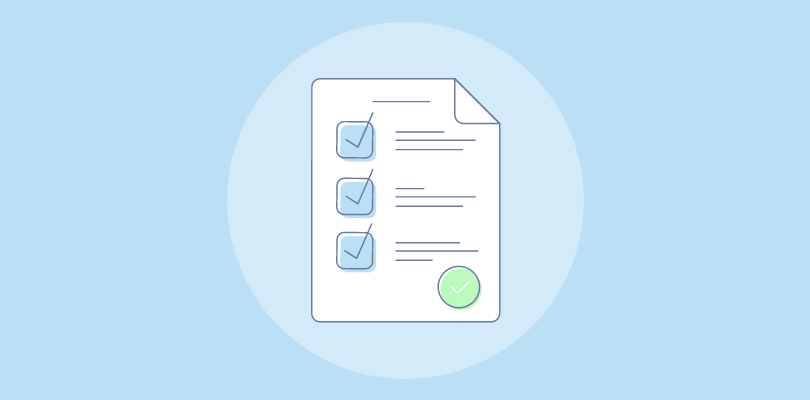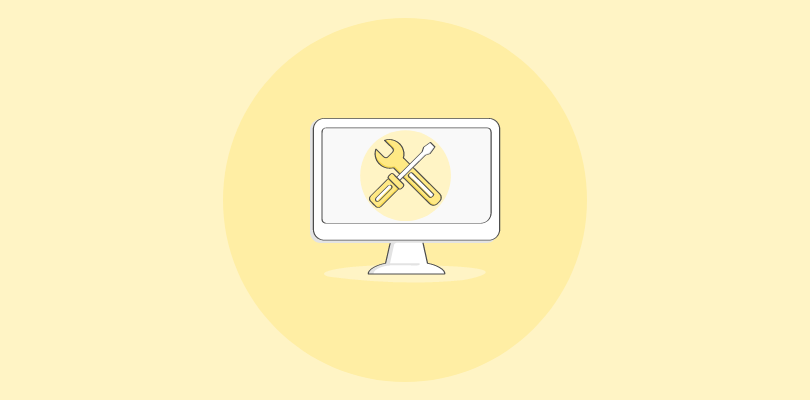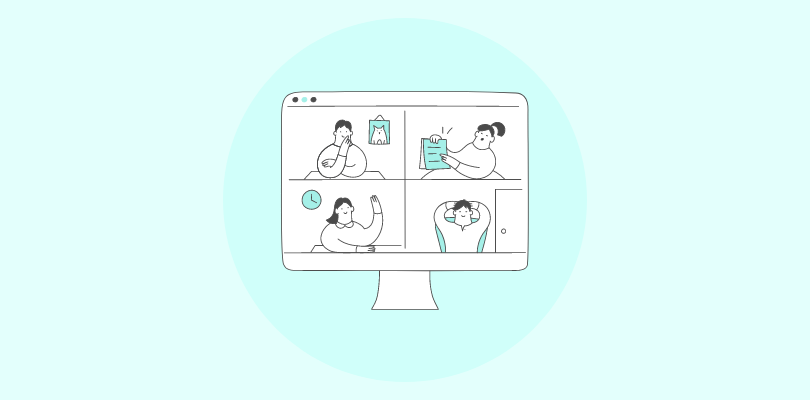Ever wonder how decisions are made about who’s fit for school or the right pick for a job? That’s where formal assessments come in.
They’re the big tests—like the SAT or coding exams for techies—that help measure what you know and can do.
Think of it as the key to unlocking new opportunities and getting a clear picture of your strengths.
So, why are these assessments so important, and how do they differ from the everyday, informal checks?
Let’s find out how formal assessments impact learning and careers, all in a nutshell.
What Is a Formal Assessment?
A formal assessment is a structured evaluation method used to systematically measure a learner’s or candidate’s knowledge, skills, or abilities against a set of predetermined criteria or standards.
This type of assessment often involves standardized tests, quizzes, essays, or practical examinations administered under controlled conditions. The results from formal assessments are typically quantifiable and can be used for making decisions regarding academic placement, certification, or employment suitability.
Let’s see a formal assessment example:
The SAT (Scholastic Assessment Test) is a standardized test widely used in the United States for college admissions. It is designed to evaluate the readiness of high school students for college-level work in areas such as mathematics, critical reading, and writing.
What Are the Differences Between Formal and Informal Assessments?
Some of the major differences between formal and informal assessments are as follows:
| Feature | Formal Assessments | Informal Assessments |
| Definition | Formal assessments are structured evaluations, such as standardized tests in education or performance reviews in employment, designed to measure individuals’ performance against a set standard. | Informal assessments are unstructured or semi-structured evaluations, like classroom observations or informal feedback sessions at work, aimed at gauging individuals’ abilities in a more flexible context. |
| Purpose | The purpose of formal assessments is to objectively measure an individual’s knowledge, skills, or performance in a specific area for comparison against a predefined standard or norm, both in educational settings and the workplace. | The purpose of informal assessments is to continuously monitor an individual’s progress and understanding, allowing for immediate adjustments in teaching strategies or work practices. |
| Examples | Examples include standardized academic tests, certification exams, annual performance reviews, and skill competency tests in the workplace. | Examples include classroom discussions, on-the-job observations, informal feedback conversations, and peer reviews in both educational and employment contexts. |
| Administration | These assessments are typically administered under controlled and standardized conditions at specific intervals, whether in schools or professional environments. | They can be conducted spontaneously, integrated into daily activities, and adapted to the situation at hand, making them highly versatile in both education and employment. |
| Scoring | Scoring involves a quantitative approach, with results often translating into grades or ratings that reflect an individual’s performance relative to the standard. | Scoring is usually qualitative, focusing on providing descriptive feedback that highlights areas of progress and improvement. |
| Use of Results | The results are used to make broad decisions regarding an individual’s educational path or employment status, such as grade advancement, certification, or promotion eligibility. | The results inform immediate instructional adjustments or workplace practices, aiding in personalized development and addressing specific needs or challenges. |
| Flexibility | Formal assessments offer low flexibility due to their standardized nature, requiring adherence to specific formats and content. | Informal assessments boast high flexibility, allowing for adjustments based on the individual’s needs, the context, and immediate feedback. |
| Focus | The focus is primarily on measuring specific knowledge, skills, or performance outcomes, often ignoring the nuances of the learning or development process. | The focus extends beyond mere outcomes, emphasizing the learning or development process itself, including problem-solving abilities, creativity, and the application of knowledge in practical contexts. |
Also Read:Informal Assessment: Definition, Examples, and Benefits
What Are the Types of Formal Assessments?
Formal assessments can be categorized as follows:
1. Standardized Tests
This is a type of formal assessment test that is designed to be administered and scored in a consistent or standard manner, which makes it applicable in educational settings for admissions (e.g., SAT, ACT) as well as in pre-employment assessment tests for evaluating certain skills or aptitudes. For example, companies might use standardized coding tests to assess the programming skills of job applicants in a fair and measurable way.
2. Skills Assessments
Skills assessments measure proficiency in specific areas relevant to both academic achievement and job performance. In education, this might include language proficiency tests such as TOEFL or IELTS for non-native speakers. In the workplace, skills assessments could evaluate a candidate’s proficiency in software like Excel or specific programming languages.
LinkedIn’s 2019 Global Talent Trends report emphasizes the increasing importance of assessing candidates’ hard and soft skills.
3. Aptitude Tests
Aptitude tests evaluate the ability to perform certain types of tasks or to learn new skills.
For example, the Differential Aptitude Tests (DAT) measure capacities in areas like verbal reasoning, numerical ability, and spatial relations, which are relevant for career counseling in educational settings and for assessing potential in job applicants.
4. Cognitive Ability Tests
These tests assess general mental capability, including memory, problem-solving skills, and logical reasoning. They are widely used in both educational environments to predict academic success and in employment settings to predict job performance.
The Wonderlic test is a good example, often used by employers to assess the cognitive abilities of potential hires. Research has shown cognitive ability tests strongly predict job performance across various industries.
5. Personality Tests
Personality assessments are used to understand an individual’s traits, motivations, and compatibility with certain environments or roles.
The Myers-Briggs Type Indicator (MBTI) is a popular tool in both education for career planning and in the workplace for team building and hiring. Despite its popularity, the scientific validity of the MBTI as a predictive tool for job success is debated among psychologists.
6. Integrity Tests
Designed to assess an individual’s honesty, dependability, and ethical stance, integrity tests are used by employers to mitigate risks in hiring. While not commonly used in educational settings for academic purposes, the principles behind these tests are relevant to educational integrity, such as adherence to honor codes.
7. Norm-Referenced Formal Assessment
A norm-referenced formal assessment is a type of evaluation that compares an individual’s performance or scores against a predefined group or norm group. The aim is to establish a ranking or distribution of performances across the population being tested, allowing an individual’s performance to be understood in relation to others. This method is particularly useful for identifying relative strengths and weaknesses within a large group.
8. Criterion-Referenced Test
A criterion-referenced test measures an individual’s performance against a specific set of criteria or standards rather than comparing scores against the scores of other test-takers. This type of test assesses whether or not test-takers have mastered a particular skill or knowledge area and to what extent. The focus is on determining what individuals know and can do independently of how others perform.
These are some of the formal assessment types, and after this, let’s check out the benefits and paybacks of the formal assessment procedures.
Also Read: 13 Different Types of Assessments You Should Know About
What Are the Benefits of Formal Assessments?
Formal assessments offer a myriad of benefits, facilitating a more structured and objective approach to evaluating skills, knowledge, and performance.
Here are some of the major benefits:
- Standardized Measurement and Comparison:
Formal assessment strategies provide a universal benchmark for measuring and comparing the performance of individuals or groups, ensuring consistency across different settings.
For instance, standardized tests like the Scholastic Assessment Test (SAT) or ACT (American College Testing) offer a common data point for college admissions, helping to equate applicants from diverse educational backgrounds on a uniform scale.
- Identification of Strengths and Weaknesses:
These assessments are instrumental in pinpointing areas where individuals excel and where they may need improvement. This targeted identification allows for personalized development plans, significantly enhancing learning outcomes.
Studies conducted by the National Center for Education Evaluation and Regional Assistance have demonstrated that interventions based on assessment results can lead to marked improvements in areas like mathematics.
- Objective Decision Making:
In both educational admissions and employment, formal assessments provide a concrete basis for decision-making, cutting through subjective biases to focus on actual abilities and potential.
Psychometric assessments in recruitment are a prime example, enabling employers to gauge a candidate’s suitability for a role beyond the resume or interview impressions.
- Setting Benchmarks and Goals:
Formal assessments set clear benchmarks, guiding individuals in their personal and professional development by establishing clear, achievable goals.
According to the Association for Talent Development, the use of these assessments in the corporate world is extensive, with 80% of Fortune 500 companies leveraging them for employee development and performance benchmarking.
- Tracking Progress Over Time:
The ability to monitor progress over time through repeated formal assessments is invaluable for gauging development, the efficacy of interventions, and long-term trends. Educational longitudinal studies often rely on such assessments to track academic growth and the impact of educational policies over the years.
- Motivation and Engagement:
By providing clear feedback and goals, formal assessments can motivate individuals to engage more deeply and improve in their areas of assessment. Gamified assessments in the workplace have been shown to boost engagement and motivation, leading to better performance and retention.
- Regulatory Compliance and Accreditation:
Formal assessments ensure that educational institutions and organizations meet regulatory standards and achieve or maintain accreditation. These standards often include the use of standardized testing results to prove adherence to quality education benchmarks.
- Informing Policy and Practice:
The data derived from formal assessments offer critical insights that can inform policy and practice in both educational and employment settings.
For example, the analysis of the Programme for International Student Assessment (PISA) results has led to educational policy reforms worldwide, highlighting the practices of top-performing countries.
Read More:Benefits of Online Assessments for Learning & Hiring: Going Beyond Traditional Evaluation Methods
FREE. All Features. FOREVER!
Try our Forever FREE account with all premium features!
Best Practices for Implementing Formal Assessments
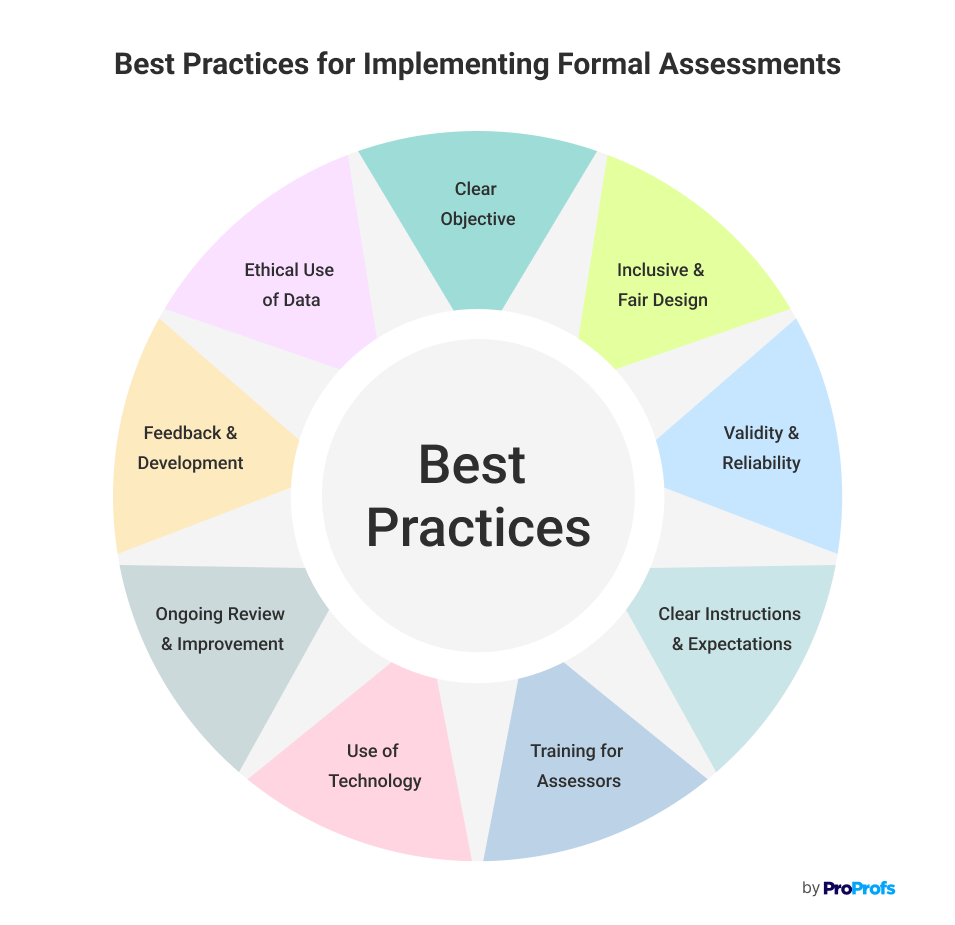
(Image Source: Sketch Bubble)
Implementing formal assessments effectively in educational or employment settings requires a strategic approach to ensure they are fair, accurate, and useful for decision-making. Here are some key best practices:
- Clear Objective
Begin with a clear understanding of what the assessment aims to measure and why. Objectives should be directly linked to the curriculum in educational settings or specific job competencies in employment contexts. This clarity ensures that assessments are purposeful and aligned with desired outcomes.
- Inclusive and Fair Design
Design assessments to be inclusive and fair, ensuring that all individuals, regardless of their background, have an equal opportunity to demonstrate their abilities. This includes considering language proficiency, cultural backgrounds, and disabilities. Using a variety of assessment methods can help accommodate diverse needs and learning styles.
- Validity and Reliability
Ensure the assessments are both valid (accurately measuring what they are supposed to measure) and reliable (providing consistent results over time and across different groups). This often involves a thorough testing and review process, including pilot testing and statistical analysis of items.
- Clear Instructions and Expectations
Provide clear instructions and criteria for assessment. Participants should know what is expected of them, how they will be evaluated, and the significance of the assessment results. This transparency helps reduce anxiety and improves the accuracy of the assessment outcomes.
- Training for Assessors
Those who design and administer assessments should be properly trained. This training should cover not only the technical aspects of the assessment process but also how to interpret results and provide constructive feedback. In employment settings, it’s crucial that assessors understand the competencies being measured and can make unbiased evaluations.
- Use of Technology
Leverage technology to administer, score, and analyze assessment results. Technology can improve the efficiency and accuracy of assessments, provide instant feedback, and enable more sophisticated analyses of results to inform teaching or training practices.
- Ongoing Review and Improvement
Regularly review and update assessments to ensure they remain relevant, valid, and fair. This involves analyzing assessment data to identify trends, biases, or areas for improvement and updating the formal assessment tools and processes accordingly.
- Feedback and Development
Provide detailed, constructive feedback to participants based on their assessment results. Feedback should be actionable, offering clear guidance on how to improve or develop further. In educational settings, this might involve personalized learning plans, while in employment contexts, it could lead to targeted training or professional development opportunities.
- Ethical Use of Data
Handle assessment data ethically, ensuring privacy and confidentiality. Use assessment results responsibly, focusing on supporting and improving individual performance rather than punitive measures.
Implementing these best practices can significantly enhance the effectiveness and fairness of formal assessments, making them valuable tools for educational advancement and professional development.
How to Create Formal Assessments Using Online Tools
Many tools in the market allow you to create formal assessments absolutely free. Let’s take the example of ProProfs Quiz Maker and learn how to create a formal assessment in two different ways:
Creating Formal Assessments using the AI Quiz Tool
Step 1: Click “Create a Quiz” on the dashboard.
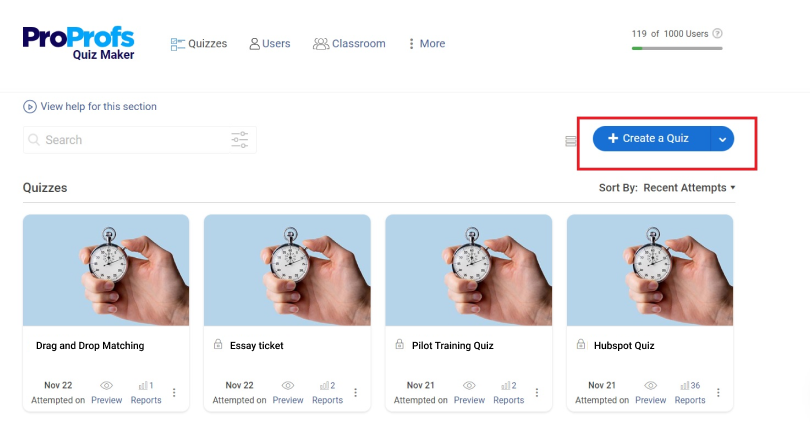
Step 2: Go to “Generate with ProProfs AI” to use the AI quiz maker.
- Provide the topic of your quiz and some additional information about it.
- Next, select the question format, the number of questions, the difficulty level, and whether you want explanations for the answers.
- Click “Generate Questions” to generate your formal assessment.
Step 3: Choose the questions you want to include in your quiz and click the “Add to Quiz” button.
Then, you can either click the “Add more questions” button to generate more questions or the “Go to Quiz” button.

Step 4: Click “Edit Cover” to add a title, description, and cover image for your quiz.
You can also add images, videos, or audio clips to your quiz to make it more engaging or visually appealing.
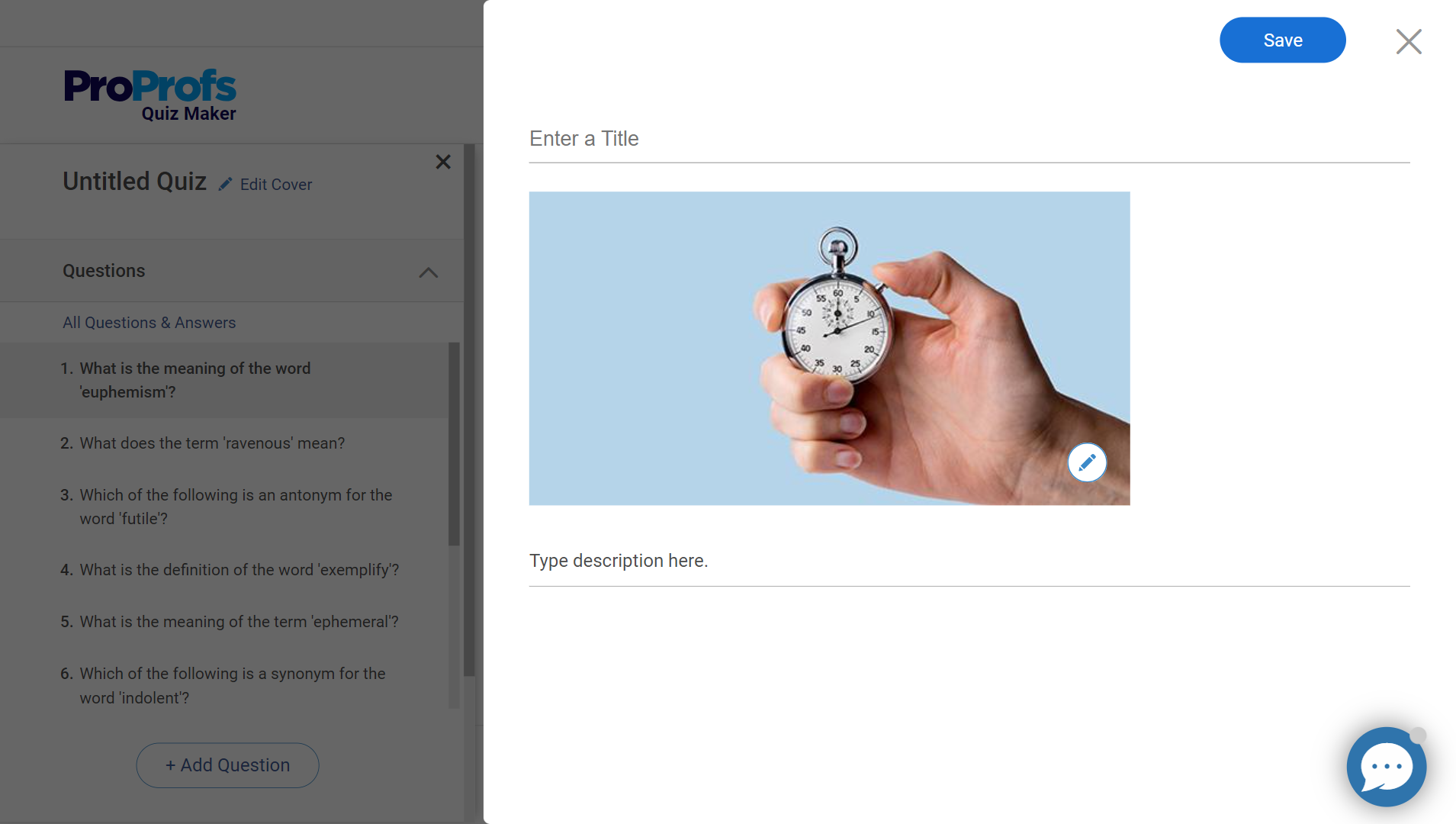
You can manually add or import some questions from the question bank of over a million ready-to-use questions.
And that’s it.
You can share this assessment with the candidates and enable automatic grading and scoring to offer quick feedback.
Creating a Formal Assessment From Scratch
If you’ve already thought of and drafted your questions, you can choose the “Create Your Own” option to build your formal assessment from the ground up. Here are the steps.
Step 1: On your dashboard, click “Create a Quiz.”
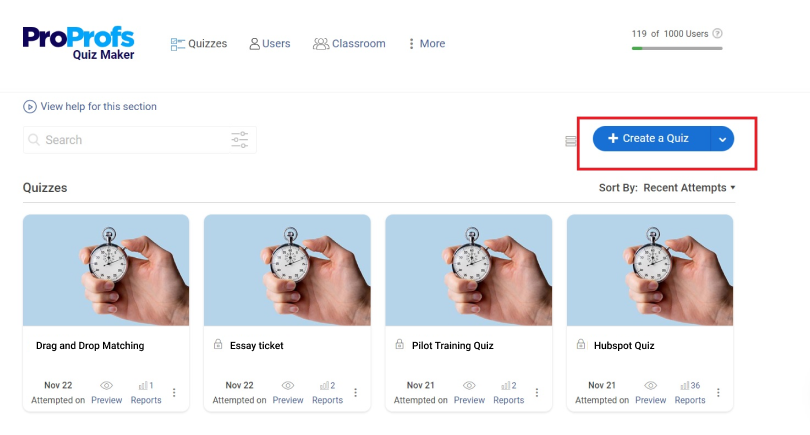
Step 2: Click the ‘Create Your Own’ button on the next screen. You’ll be taken to the quiz editor window, where you can start building your quiz.
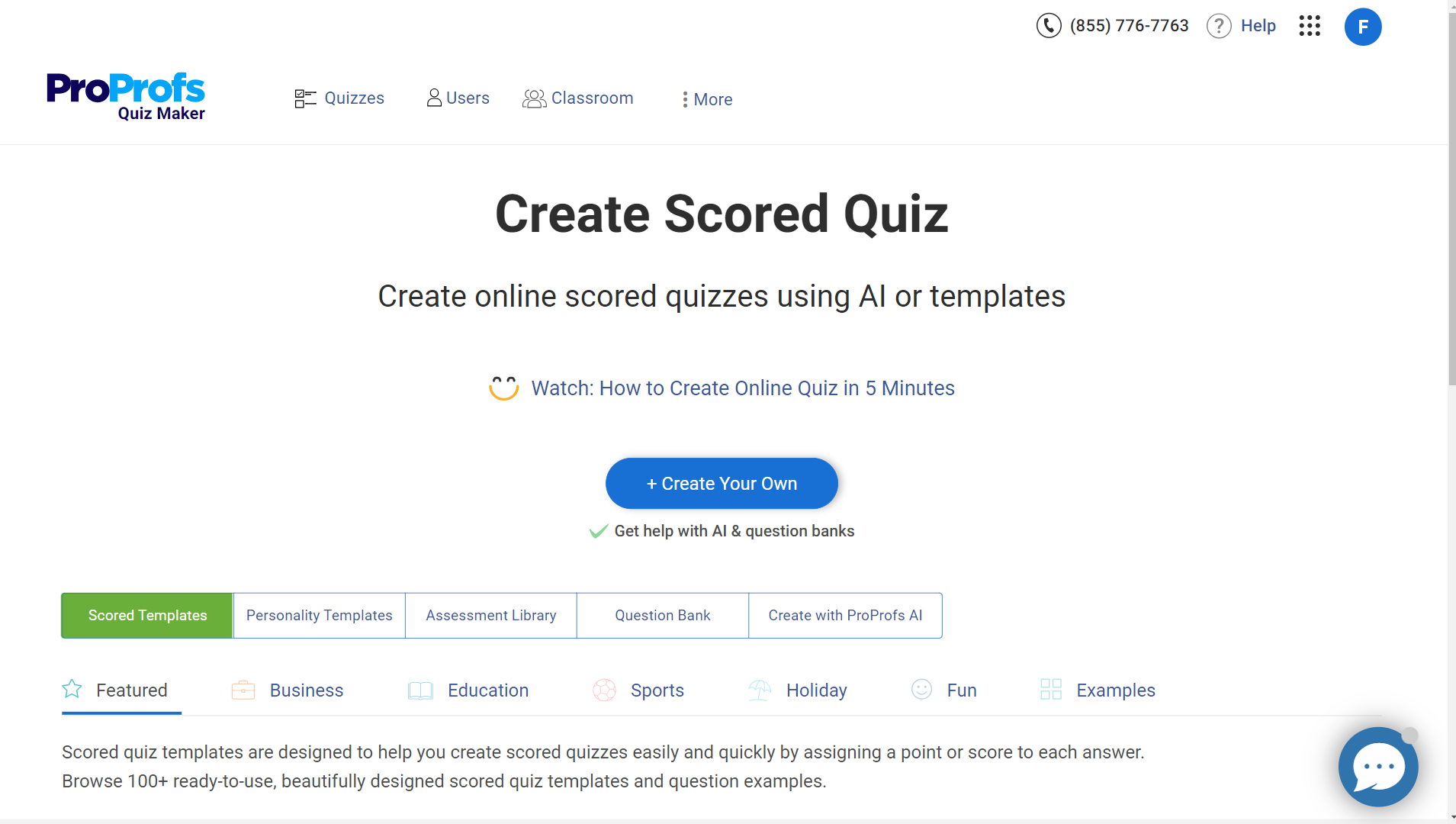
Step 3: Click “Edit Cover” to add the quiz title, description, and cover image.
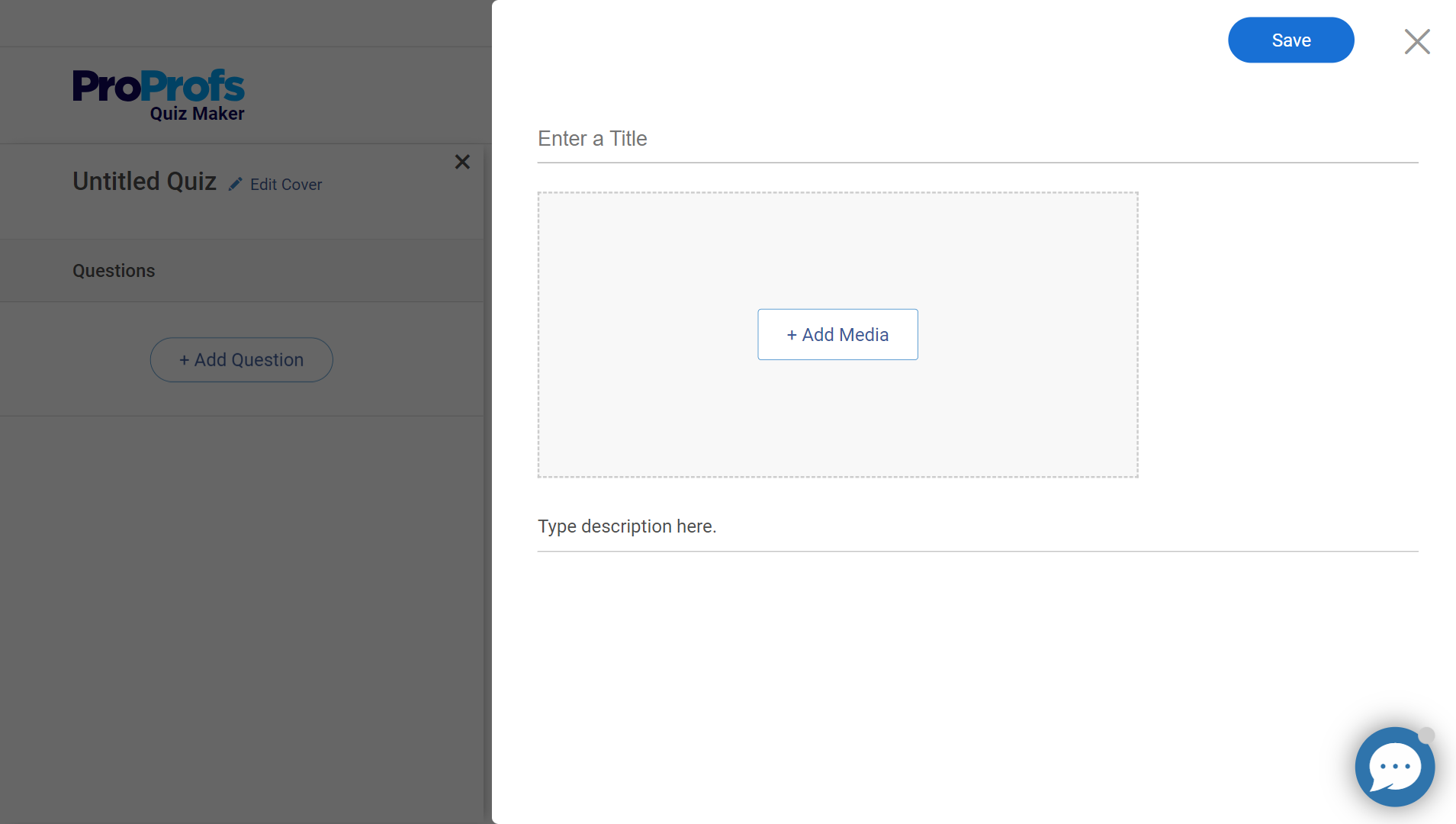
Step 4: Click “Add Question” on the panel on the right and choose a question format.
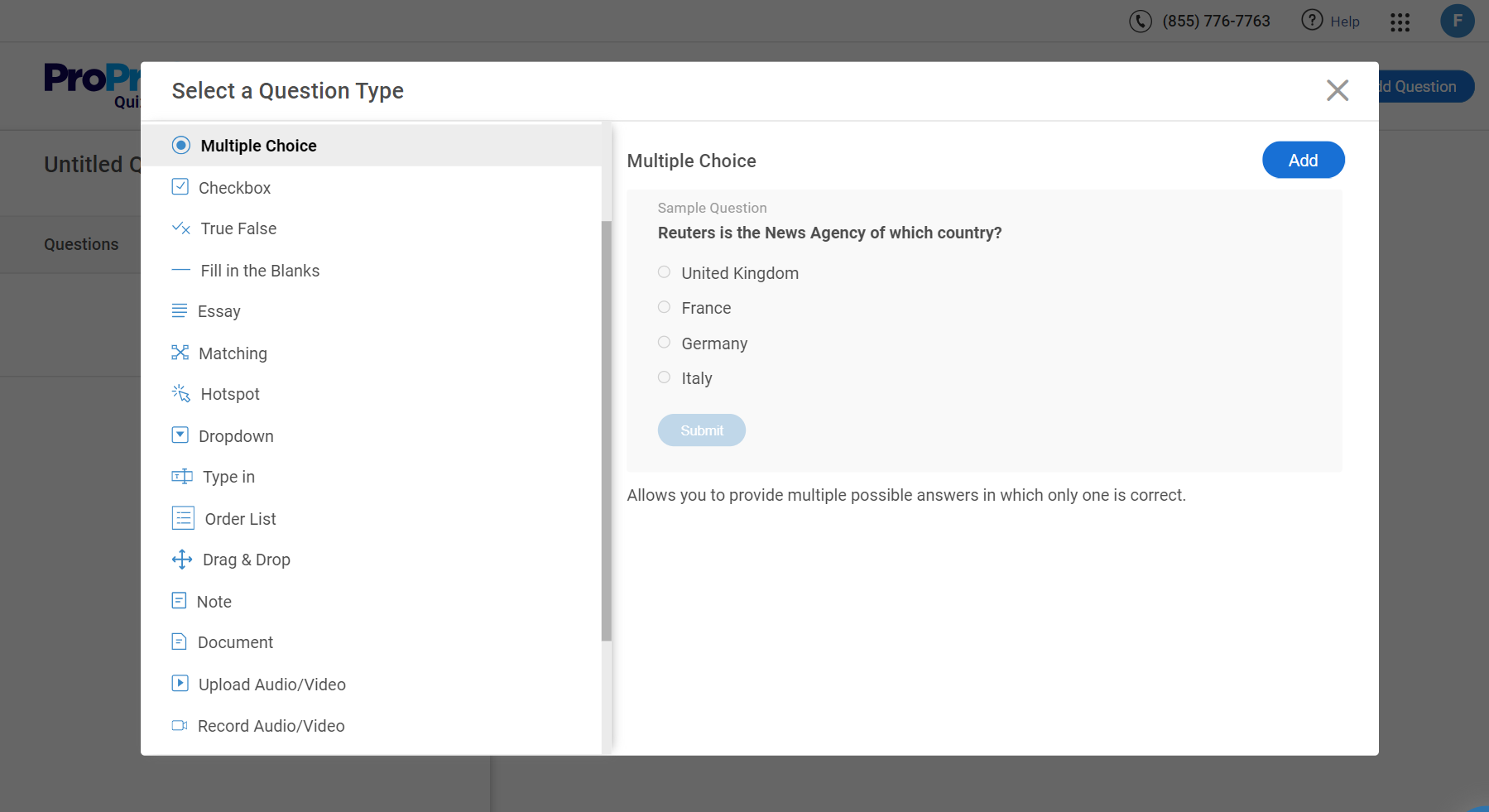
You can choose from 15+ question types, as shown in the video below.
Repeat this step till you’ve created all the questions. You can create your quiz with a single question type, such as MCQ, or have a mix of questions to make your quiz more interesting and fun.
Step 5: Add Instant Feedback
You can display instant feedback when a question is answered. Doing so helps your learners identify knowledge gaps and improve their learning.
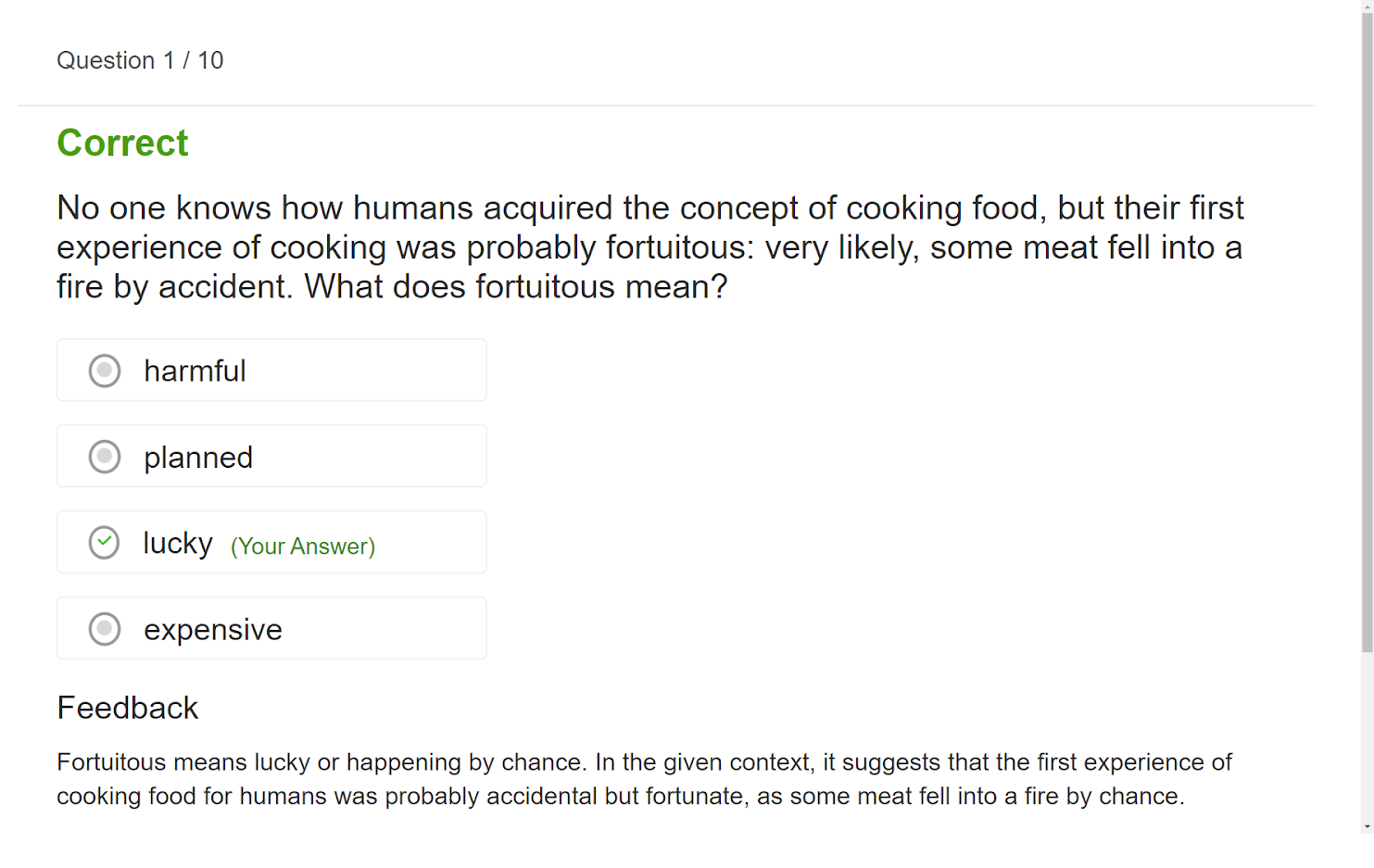
Read: How to Add Feedback to Answers
Also Watch: How to Create an Online Quiz in Under 5 Mins
Decoding Performance with Effective Formal Assessments
Formal assessments play a crucial role in both educational and employment sectors by providing a structured approach to evaluating knowledge, skills, and performance. These assessments offer invaluable insights into learners’ and employees’ competencies, guiding future learning paths and career advancements.
If you are looking to navigate through the complexities of creating effective formal assessments, ProProfs Quiz Maker can be a good partner. Its intuitive design, extensive question bank, and detailed analytics, along with the efficient AI quiz generator, make it an ideal choice for crafting assessments that are not only comprehensive but also tailored to meet specific educational and employment needs.
Learn More About Formal Assessments
Is a worksheet a formal assessment?
A worksheet can be a formal assessment if it is designed to evaluate learners’ knowledge or skills against specific standards systematically. In this context, formal assessments are structured, employ standard scoring methods, and contribute to official grades or evaluations. However, worksheets can vary in nature; they can also be informal, intended for practice or reinforcement of concepts, without affecting formal assessment records.
Can a formal assessment be formative?
Yes, a formal assessment can serve a formative purpose. Although formal assessments are structured and standardized, they can be utilized formatively to gather data on learning during the instructional process. The goal of formative formal assessments is to provide feedback that educators can use to adjust teaching strategies and help them improve their understanding.
Also Read:20 Best Formative Assessment Tools of 2024
Is a formal assessment the same as a summative assessment?
Formal assessment encompasses more than just summative assessment. Summative assessments are a subset of formal assessments designed to evaluate student learning at the conclusion of an instructional unit or course. They are typically structured and standardized and contribute to final grades. However, formal assessments can also be formative, aimed at guiding instruction and improving the learning throughout the course.
Read More: Formative vs. Summative Assessment: Differences & Similarities
What are the cons of a formal assessment?
Formal assessments face several drawbacks, including inducing stress among learners, emphasizing memorization over critical thinking, and potentially narrowing the curriculum to what is testable. They may not accurately reflect a learner’s full range of abilities or learning progress, especially in areas like creativity or problem-solving. Also, preparing for and administering formal assessments can consume valuable teaching time, detracting from interactive and explorative learning opportunities.
 Tips
Tips
We’d love to hear your tips & suggestions on this article!
FREE. All Features. FOREVER!
Try our Forever FREE account with all premium features!
 We'd love your feedback!
We'd love your feedback! Thanks for your feedback!
Thanks for your feedback!

